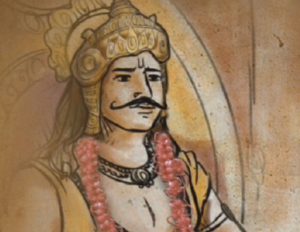Sources
- Two major sources of information regarding the Pushyabhuti dynasty are the Harshacharita, a prose biography written by Banabhatta, court poet of king Harshavardhana, and the account of the Chinese pilgrim Xuanzang.
Story
- The Pushyabhutis initially had their base in the area around Sthanishvara (modern Thanesar in Punjab). The fourth king of the line was Prabhakaravardhana, described in the Harshacharita as a great general with many military victories to his credit. With the marriage of princess Rajyashri to the Maukhari ruler Grahavarman, an important marriage alliance was forged between the Pushyabhutis and the Maukharis of Kanyakubja, who were their neighbours to the east.
- Prabhakaravardhana died and was succeeded by his son Rajyavardhana in c. 605 CE. Close on the heels of this event, Grahavarman was killed by the king of Malava, and Rajyashri was imprisoned.
- Leaving the reigns of governance in the hands of his younger brother Harshavardhana, Rajyavardhana marched towards Kanyakubja (Kanauj), defeating the Malava army along the way. His next encounter was with the army of Shashanka, ruler of Gauda (in Bengal). According to the story given in the Harshacharita, Rajyavardhana was killed by Shashanka through a stratagem. Harshavardhana became king.

Territorial expansion
- One of his first actions was to rush towards Kanyakubja and rescue his sister, who was on the verge of committing sati. Kanauj subsequently passed into the hands of the Pushyabhutis.
- Harsha probably defeated Shashanka and extended his control over parts of Kongoda in Orissa. He was victorious against the ruler of Sindh in the north-west and Valabhi in the west. He impressed his might on Kashmir. However, he suffered a crushing defeat at the hands of the Western Chalukya ruler Pulakeshin II.
- There are different assessments of Harsha’s empire. He seems to have had direct control over Thanesar, Kanauj, Ahichchhatra, Shravasti, and Prayaga, and he extended his empire into Magadha and Orissa. The Narmada was the southern boundary of his empire. In the east, Bhaskaravarman (king of Kamarupa) and Dhruvabhata accepted his overlordship, while in the west, the king of Valabhi did likewise. The forest chiefs of the Vindhyas also recognized his overlordship.
- This seems to have involved the payment of tribute as well as military alliance. Some of the subordinate rulers, who had titles such as raja, samanta, and mahasamanta, used the Harsha era of 606 CE in their inscriptions.
Xuanzang (Hiuen Tsang )
- Embassies were exchanged with China during Harshavardhana’s reign. Xuanzang gives a vivid description of the beauty, grandeur, and prosperity of Kanauj, the capital of Harsha’s empire.
- Regarding the king, he tells us that he divided the day into three parts— attending to administrative duties during one, and devoting himself to religious works during the other two. He mentions Harsha making frequent tours of inspection around his kingdom.
- Periodic assemblies, attended by subordinate kings, reinforced the political hierarchy.
- Harsha is known to have made religious land grants, and Xuanzang suggests that ministers and officials may also have been paid through such grants.
Adminstration
- We do not have much detail regarding Harshavardhana’s adminstration, but there seems broad continuity in official designations from the Gupta period.
- Bana mentions forest guards known as vanapalas. There is mention of an official called the sarva-palli-pati (chief of all the villages).
- Xuanzang states that people were taxed lightly and that the king took one-sixth of the farmer’s produce as his grain share. Inscriptions mention dues such as bhaga, bhoga, kara, and hiranya—terms known from earlier inscriptions.
- Xuanzang gives a stereotyped description of the army as consisting of infantry, cavalry, chariots, and elephants. The Banskhera and Madhuban inscriptions refer to the king’s camp of victory containing boats, elephants, and horses.
Religion
- Inscriptional evidence suggests that the early Pushyabhuti rulers were worshippers of Surya. Rajyavardhana was a devotee of the Buddha. Harshavardhana seems to have been a devotee of Shiva, but was also partial towards Buddhism.
- He convened a great assembly at Kanauj, where Xuanzang, along with many others, gave discourses on Mahayana doctrines. We are told that Shramanas, Brahmanas, and adherents of various sects were invited to this grand conclave. Various subordinate kings, including those of Assam and Valabhi, were also present.
Learning and the arts
- Harshavardhana was a patron of learning and the arts, and had various talents himself. He is supposed to have written three dramas, a work on grammar, and at least two Sutra works. The three plays attributed to him are the Ratnavali, Priyadarshika, and Nagananda. The Nagananda is about the bodhisattva Jimutavahana, and the Ratnavali and Priyadarshika are romantic comedies.
- It is possible that the king himself composed the text of the Banskhera and Madhuban inscriptions. The Banskhera inscription has the king’s signature and shows his calligraphic skills. Bana tells us that the king was an accomplished lute player.
- Bana, Mayura, and Matanga Divakara were among the accomplished writers associated with his court.
- Harsha’s death in 648 CE was followed by a period of political confusion until the rise of Yashovarman in c. 715–45 CE.
- Thereafter, a number of lineages vied for control over Kanauj. One of the striking features of the political history of the times was what is known as the tripartite struggle between the Rashtrakutas, Palas, and Gurjara-Pratiharas.
Also read-
